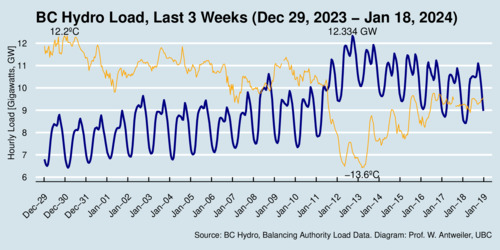
click on image for high-resolution PDF version
The lights did not go out in British Columbia on January 12, 2024 between 6pm and 7pm, when BC Hydro's system reached a new peak load of 12.334 Gigawatts [GW]. While Alberta's new peak demand triggered peak load interventions and an appeal to households to conserve electricity, no such intervention was needed in BC. The new peak load in BC coincided with a cold spell as the orange line in the graph shows. At YVR, Vancouver's international airport, the thermometer dropped to –13.6°C. For Vancouver standards, that is bitterly cold (yes, folks in Saskatchewan will laugh now). But BC Hydro's system held firm, with a little help of imports from the United States (see my blog BC has become a net electricity importer in 2023).
I have estimated that during the last three weeks, each drop by 1°C increased the load in the system by about 172 Megawatts [MW], roughly a 2% change to the load. A cold snap like that a week ago is rare.
What is the limit of BC Hydro's capacity. On its quick facts sheet, it lists at total capacity of 12.159 GW. Add to that the capacity of interties (about 2 GW to the United States, and 1 GW from Alberta), and there is some slack in the system to deal with even higher demand than we experienced a week ago. Once Site-C dam comes online later in 2024, constraints on the system should ease significantly.
BC Hydro's forthcoming Clean Power Call will bring another 3,000 GWh of energy into the system, and it will be interesting to see how this will translate into additional generating capacity. The Independent Power Producer supply list shows large variation in the energy-to-power ratio. Take the large wind farms, for example. Tumbler Ridge has two major farms, Meikle and Quality with 184.5 MW and 142.2 MW nameplate capacity, rated as delivering 541.0 GWh and 476.9 GWh per year, respectively. As there are 8,760 hours in a year, this translates into utilization rates of 33.5% and 38.3%. This means if all of the 3,000 GWh from the Clean Power Call was provided by new wind farms, we could expect just over 1,000 MW of new nameplate capacity for wind farms—equivalent to roughly five or six new projects of the size of the Meikle Wind project or Quality Wind project.
This article has been updated with a new version of the image to correct a data error on January 17 that was contained in preliminary data released by BC Hydro in January. This article has also been amended with a link to the Powerex report about the peak event.
- Powerex: Analysis of the January 2024 Winter Weather Event, March 6, 2024.
![[Sauder School of Business]](logo-ubc-sauder-2016.png)
![[The University of British Columbia]](logo-ubc-2016.png)